 I think the importance of immediate feedback, or a later (1 to 7 day) fresh eye appraisal is always important when sketching a portrait.
I think the importance of immediate feedback, or a later (1 to 7 day) fresh eye appraisal is always important when sketching a portrait.
I think it’s important too to take a breath when reaching for a likeness on paper or canvas.
What do I mean by that? I mean it’s important to take a moment to look over the finished piece either immediately while you can still compare the model, or one to several days later when even if you no longer have the model or reference material you can look to see what works on a “normal human face,” what stands out as glaring, what is wrong about the lighting or anatomy.
I had a different post for today, short: Stop and check yourself, do a quick thumbnail revision and talk yourself through when and where you went off the rails. Maybe that’s enough for you, go do that.
Otherwise keep reading.
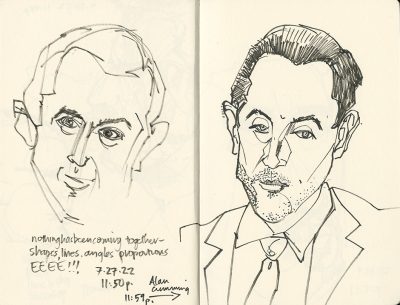
That’s what you see on the page spread that opens this post. I did the full sketch on the recto page first, then I did a little bit of self-feedback pointing out to myself things I need to look at in the future so I can improve in general when drawing faces, but in specific also if I redraw this face—which is the face of actor Alan Cumming.
(You can also read the text on that page clicking to see the enlargement.)
But I had a note from an UrbanSketcher friend about portraits and likeness this past week and her question involves a need for self-analysis that I think we all need to look at in our work. Tina Koyama wrote to me:
Since I know you enjoy portraiture, I’d like your thoughts on this: Ever since Inktober last year (so almost daily for almost 5 months), I’ve been making portraits based on Earthsworld’s photos. I had never seriously practiced portraiture before October. Initially my goal was to improve resemblance, but because I knew I could always eventually get to a good likeness if I took enough time, a secondary goal was to spend no more than about 15-30 minutes each. Now that I’ve made about 150, I can see definite improvements in resemblance, but now my goal is to be a little looser and fresher and not so “tight.” When I’m “tight,” I have a better chance of getting a likeness, but as soon as I become more expressive, it’s at the expense of resemblance. If you want to see what I’m doing, here’s a Flickr album where I’m putting all the portraits: Gallery. Of course, I don’t show the reference photos, so you won’t be able to see whether I achieved a good resemblance, but I suppose that’s not important for this discussion. Here’s what I’m really getting at:
It bothers me that I am so hung up about likeness — I know it’s not the most important thing about portraiture — but I can’t seem to let it go. I feel like if I don’t at least try for resemblance, then I might as well be drawing faces from imagination. Any advice or thoughts on this?
Tina’s in the “needs to take a breath” moment. She’s in her brain too much about this and she also may need to simply breath and slow down again.
Tina does lovely work. I recognize her sketches as people photographed by Earth’s World because I sketch a lot from those photos myself. She has “enough” likeness that someone can recognize the source.
So what is important here?
As an UrbanSketcher it really isn’t vital that Tina produce recognizable portraits. But it’s clear that she wants to. And she seems to have a goal because she has been working at portraiture for some months now.
It’s going to sound repetitive, but I think this is really a simple case of the goals and intentions not being clearly defined yet.
Tina doesn’t see something in her portraits that she wants to see.
Since I can see likeness in her portraits this is one of those situations where only Tina can decide what it is she wants to see. But there is a way we can all go about looking for this answer in our own work.
Goals and Intentions: Reining in Expectations
The reason it’s important to set goals for your artwork is so you go along the path you desire, and have some hope of achieving what you are after. But if we aren’t clear in those intentions or expectations then what we see on paper will disappoint and confuse us. Double that confusion if you have an active internal critic (because there will also be some messy cross chat).
The goal in portraiture is simple, and there is only one: Produce a recognizable likeness of the subject.
This is different from the goal of drawing figures recognizable as people. That’s a goal that is very common in UrbanSketchers. They want people in their sketches but they aren’t even trying to have those figures be recognizable as specific individuals like Joe Hamilton, Rory Kent, Lou Ann Smith, etc. (those are just made up names, you get the idea).
Some UrbanSketchers go so “abstract” with the figures because they simply want the scale (people to buildings) to help “sell” the image they are creating; or they just want the life that figures bring to a landscape.
If you’re involved in any sort of urban sketching or visual journaling through your day your first need if you want to draw people is to state clearly to yourself your goal in drawing people.
Is your goal portraiture (and then the need for likeness) or is your goal depiction of humanity (where loose abstraction or stylization can suffice)?
Once you decide that then you know what your intention is.
Let’s look at the intention of portraiture to go for likeness.
Going for likeness doesn’t mean you’re always going to get it. I’ve written quite a lot about this. One is constantly going on little fact finding expeditions of the face under consideration. (Hence the usefulness of the follow-up break down of where you need to improve—whether it’s getting your angles and proportions right, or nailing the features that really sell this individual.)
Once you know your goal is to go for likeness and you set up a feedback system, you can then rein in your expectations. This means that you’ll be able to enjoy those portraits where you come close to getting all that you want in them. And most important you’ll enjoy the process and you won’t be frustrated by not always getting the likeness.
Tina’s frustration is clear in her sentence:
Of course, I don’t show the reference photos, so you won’t be able to see whether I achieved a good resemblance, but I suppose that’s not important for this discussion.
But it is important for this discussion and this shows she’s in her own mind about what her real goal is. If she wants to draw people for urban sketching situations it isn’t important to have any resemblance to a particular person, but if she wants to do portraiture it is essential.
One of the reasons that the old Masters’ portraits still speak to us hundreds of years after they were painted, when we no longer have the individual to compare to the artwork (and until relatively recently didn’t have photography as a reference either) is that the artists captured something alive about the people they were painting.
In paintings by Rembrandt, or the Flemish Masters, or DaVinci, or Holbein, or more recently the Impressionists when people are included in close up, we are looking at a specific, not a type. We are looking at an individual. The artist is READING something about the face he is looking at. The artist interprets what he is looking at. The artist gives all that analysis and observation over to the audience through what goes down on paper or canvas.
Ultimately, for people interested in portraiture, it allows the artist to say something specific about an individual, and in really great work—something transcendent that speaks of the universal.
I remember a painting of Rembrandt’s of a young woman wearing a pearl necklace and staring out at the viewer. I think the painting may have been of his wife (all my art books are still in storage so the museum catalog I need is out of my grasp). It’s a direct stare forward, full face.
I went back five times to the museum to look at that painting. (Sure after visit one there were a couple paintings I also had a second look at, but this one wouldn’t let me go.)
First, when an artist makes something that self-assured and clear the audience counts it as accurate, even without a photo handy, we know the artist would have corrected and altered until it was accurate. That’s craftsmanship.
Next there is something so accomplished in the understanding of the musculature and features that we see the reality of this painting as a depiction of a human.
Beyond that there is something so particular in the dispersal of light to draw our attention and focus to what the artist sees that this tells us something specific about this individual. We know we are looking at an actual person, a specific person, and we can see her hopes and dreams in her face.
And we can tell how the artist felt about the subject—the interest, the looking, the investigating. And I think in this particular instance also love. Those are all specifics to the individual and they are good goals for us as artists to strive for. Love, hate, fear, disgust, empathy, sympathy—these are all things the artist can show us about his attitude to the subject.
But first we have to get those specifics of likeness down, and of course that takes practice. Tina isn’t afraid of practice, she’s sketching all the time, wonderful sketches of landscapes, urban scenes, and people. That’s why I think Tina just needs to take a breath and get out of her head. And allow herself some more time.
The Issue of Looseness and Tightness
Tina also mentioned that she can do something in 15-30 minutes that is a good likeness, but her “goal” is to be “a little looser and fresher.” As soon as she becomes more expressive “it’s at the expense of resemblance.”
This is something I see in students who are working with goals way out in front of where they are. When we speed up and loose our main quality or goal (in this instance the likeness essential to have portraiture) we have to slow down and remind ourselves that for now we have to work somewhere in that space where we still learn what likeness is. Or better, what likeness is for the current subject.
I think the best thing in this situation is two fold: more sketching of portraits and looking for those features that convey likeness in your mind; and looking ahead at where you want to go stylistically. Is there an artist who draws and paints in a way that you like.
I was just talking with my students the other day about illustrator Steve Brodner. I think his work is amazing. As a visual commentator on life and politics in the US for the past fifty years or so no one can more elegantly identify and put on paper the key features that make his portraits immediately recognizable. (And of course the sub-story is always readable through expression and action in his work.)
So if one wanted to do something like that, a possible course of action would be to study the work and analyze how he treads the line between stylization and realism in order to get that expression into his work.
In that analysis of your “favorite’s” work you’ll start to see things you never saw before. You will start to look for those things when you draw. Because we are all different in so many ways—besides the obvious one of simple control we may or may not have over our tools—your work will continue to look different from your “favorite’s” but you’ll start to “get it” when you look at a face. And more of what you see and “get” will work itself into your work. And along the way you may also discover a style.
Moving Out of Tightness
There’s another key factor to sketching portraits. I believe with portraits, as I do with all my drawing subjects, that it is best to draw from life. It’s the way I teach my drawing classes, and it’s my own preferred way to sketch and paint.
I believe that the best way to draw portraits, and get better at drawing them when you want to do them and you are sketching around town, is to go to life drawing!
Why is it important to go to life drawing?
Well you’re drawing a three dimensional subject in space. Your eye has to make a bazillion decisions about the way a subject looks in life and how you can get that down on paper. There’s the lighting, the anatomy. There’s the composition you have to come up with. You can move around the subject in most life-drawing situations.
Even if you go to a life drawing co-op where they do short poses first you can still work on your portraiture skills—in those fast poses you can practice working on getting down the essence of expression before the time is called and the subject repositions. You may find that you rely too heavily on line and that in a short period of time you need to rely on areas of value, or the opposite. It doesn’t matter, those discoveries will help you when you go out into the world and try to sketch people.
Going to life drawing and working on portraiture is valuable for another reason as well.
You get to draw the same face over and over (if you have repeating models, and all co-ops I’ve gone to do). That repetition of seeing the same model, and getting that same model on the paper or canvas again and again allows you to realize that on any given day, in any lighting, different things make a person look different. They aren’t going to look exactly the same every time—and it’s not just you as an artist.
I can look back at my co-op portraits and tell which model is which, there is likeness, but with a string of sketches of the same model over time there are differences (a bad day for the model, preoccupation, a new hair cut, different lighting showing me something new, and in some cases, with models I’ve drawn over the years, aging; and that’s before we get to issues of my own improving skill).
Each time you draw someone from life you get to see what you got “right” on that day, but after maybe 30 or more attempts at sketching that same person you begin to see what you need as an artist to include for a likeness of that person.
I find that very exciting, and infinitely interesting.
Why Likeness Matters to Me
Tina feels if she “doesn’t at least try for resemblance, then I might as well be drawing faces from imagination.”
Yep, that’s right. And drawing from imagination doesn’t interest me.
I think from her struggling with this question it doesn’t interest her to draw from imagination either.
And that gets to the answer of her question—still go for the likeness and get out of your own way when it doesn’t happen. Learn from it and keep going. That’s the goal and intention.
My journal is about specifics and particulars, so when I draw people in the field I aim for a likeness even if I don’t get one.
That’s the goal of sketching from life when I’m out and about. And it’s my intention. When I don’t get a likeness I’ll work toward something that at least looks human. Then I’ll do a self-analysis of the situation and look at where I need to focus (getting angles right, or my proportions, etc.) and learn from that and go on.
That’s what I suggest for everyone, if your interest is in portraiture.
Right now, depending on where you live and your health situation, you may find you can’t go to life drawing. I’ve been away from drawing co-op since 2019 and I feel the loss of it every day. But I remind myself that for now it’s not advisable for me to go. When things change for me I’ll be the first one at the door again. In the meantime Dick is around and I can ask him to sit still while I sketch. And I have my dinosaurs which I can walk around and draw from different angles. And of course peppers and other foodstuffs.
The point is we can all still be practicing even if we aren’t able to go out.
But we do have to do our practice with live or still life subjects. Working from photographs will lead to a type of tightness that doesn’t bring likeness, but actually camouflages it.
A photograph is a millisecond in time. Something our human eye can certainly notice, but which we practice melding together with other milliseconds as our brain and hand catch up and we draw. Our brain is constantly moving between these various “views” and making minute and infinitely speedy decisions about which view is the best or most accurate for likeness. When we sketch from photographs we have our hand and brain literally tied. We aren’t receiving a constant stream of information.
Should we not draw from photos? I don’t like to use the word “should.”
I will say that we NEED to draw from life.
If we have circumstances where we can’t get to life-drawing or even out and about, then part of our practice might be from photographs. But as I always tell my students, if you draw from photos for an hour a day, you need to counteract that with drawing from life for an equal amount of time each day.
It’s about balance, and about taking our “vitamins.”
But first, get very clear on your goals. Set your intention for every sketch outing or session you do. And constantly look at what you completed and see where you can go from there, how you can grow from what you got down on paper.
These simple actions will ensure that your expectations aren’t going to derail your progress.



















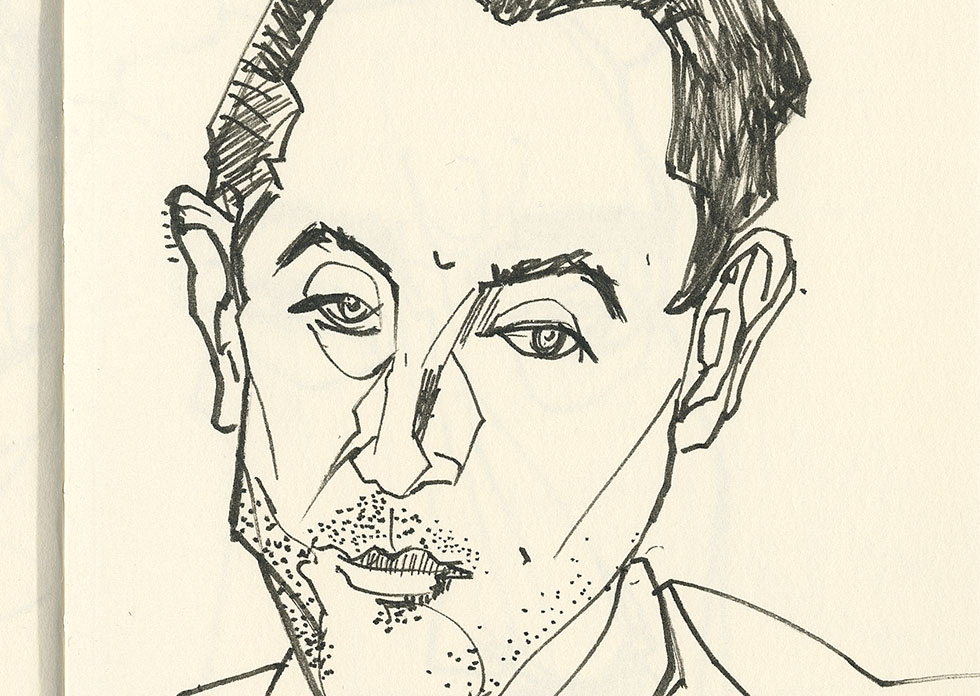
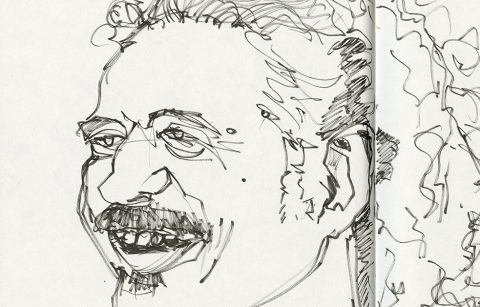
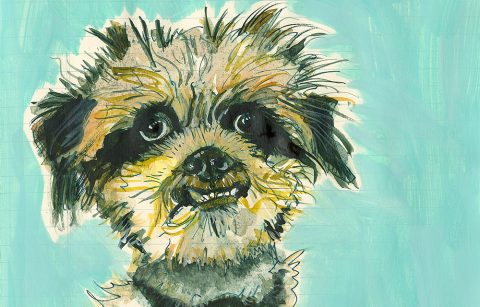
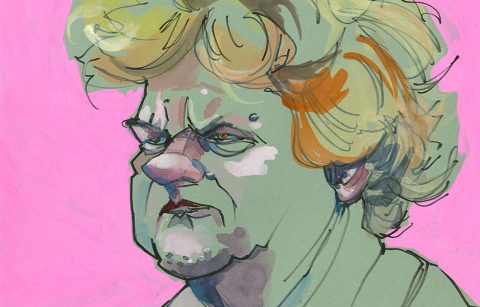
ROZ, I completely agree with you on drawing from life. I am an urban sketcher and a loose painter. In my sketches, figures may as well be carrots, but in portraiture I want to have a resemblance. But when I say that, my goals also include that it should be somewhat loose. For me it is less an exact likeness and more a, you can tell who it is because I have captured something particular about that person. About their energy, or character. It is not so much a characature, and more about trying to meld what we see and who they are together. Does this make sense?
Suzala, I think the best likeness is always when we capture something particular about a person energy or character. It’s what keeps us coming back to try again and again. So it makes total sense to me you feel this way. How loose we may do it because of our intentions is the pathway to style. Keep having fun.
Roz, thank you so much for your thorough and thoughtful response. You have addressed much of what I think about a lot (as you say, I’m in my head too much 😉 ), and I need to clarify my goals for myself. I also should give myself more credit for the improvements I’ve made after 150+ portraits in 5 months — I do see the general trend toward greater resemblance. I guess I just get impatient and expect to see more consistent results.
Re: your comments about life drawing: I agree 100% that that’s the best way to learn and practice drawing people — faces, bodies, everything. (Frankly, I think drawing ANYTHING from life is better than drawing from photos.) I used to go to life drawing very regularly (for figure, not so much for portraiture) in the pre-pandemic days, and I miss it so much. It was my winter mainstay when the weather wouldn’t allow urban sketching. Someday I hope to feel safe enough to go back. I hope you’ll be able to go back sometime, too.
Thank you again for your response. I knew you would have something to say about it!
Tina, well you know me, I love it when someone asks an interesting question that will actually help others. And I’m not worried about you at all because I know it’s those pesky USkers you hang out with that are confusing your mind. (Big smile.)
Actually you do need to give yourself way more credit because I see the pay off in your Earth’s World sketches. I see likeness. Sometimes when we don’t see the exact cues of likeness that we would like to see we also get impatient. I figure that’s our cue to look closer and decide what it is we want.
Impatience is a thing we all have, especially when we are out and about sketching fast. It’s great that you have been pursuing this portrait practice to get the accuracy of likeness down, because it will all speed up over time. And be more consistent. Though remember even Sargent complained along the lines of a portrait is a painting of a face with something wrong about the mouth. (I don’t recall the actual quote, though I use to put it on the cover of our portrait party editions!)
I hope you can get back into life drawing soon. I’m going crazy sketching from photos as it’s just not as fun. I look forward to seeing the fun stuff you come up with!
Thanks again, Roz! I appreciate all your encouragement.